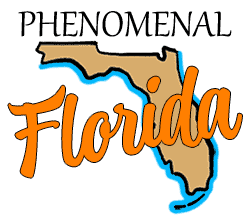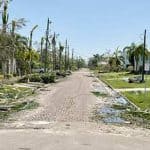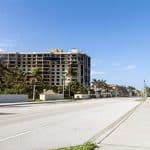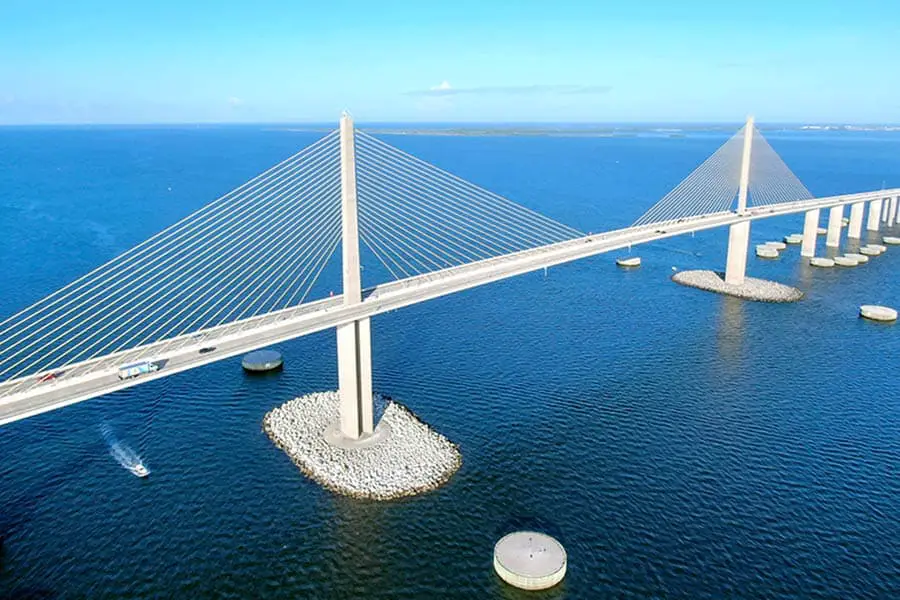
The Sunshine Skyway Bridge connects the Pinellas Peninsula and the city of St. Petersburg, Florida, to Terra Ceia. The bridge is an instantly recognizable icon of the Tampa Bay area, with its twin pylons reaching high into the sky over the bridge’s deck. But why is the Sunshine Skyway Bridge so tall?
The deck of the Sunshine Skyway Bridge sits 190 feet above the surface of Tampa Bay. Building the bridge deck at such a height lets large ships sail in and out of Tampa Bay by passing under the bridge and eliminates interruptions to traffic flow caused by draw bridges.
How steep is the Skyway? Does it light up at night? Can you walk across it or catch fish from it? I’ll tell you the answers to these questions and more in the following sections.
The Sunshine Skyway: The Latest & Greatest Bridge Across Tampa Bay
The Sunshine Skyway Bridge is very tall, standing 190 feet above the surface of the water. This is an enormous height, about as tall as a 15- to 20-story building. The Skyway was built with this height because large vessels need to sail under the Skyway to enter Tampa Bay: the only path into Tampa Bay from the ocean takes ships right under the bridge. Therefore, any vessel that needs to enter or exit the bay has to sail under the Skyway.
Vessels include not just freighters but also cruise ships. Multiple cruise lines sail in and out of Tampa Bay, taking revelers on trips to the Caribbean and the Gulf of Mexico. In addition, the Port of Tampa hosts maritime operations for a variety of different ocean-going vessels that must pass beneath the Skyway to enter the Gulf of Mexico.
While the bridge’s height is still adequate, in the time since the Skyway was built, vessels have only gotten bigger and bigger, and some modern freighters and cruise liners actually wouldn’t be able to sail under the Skyway.
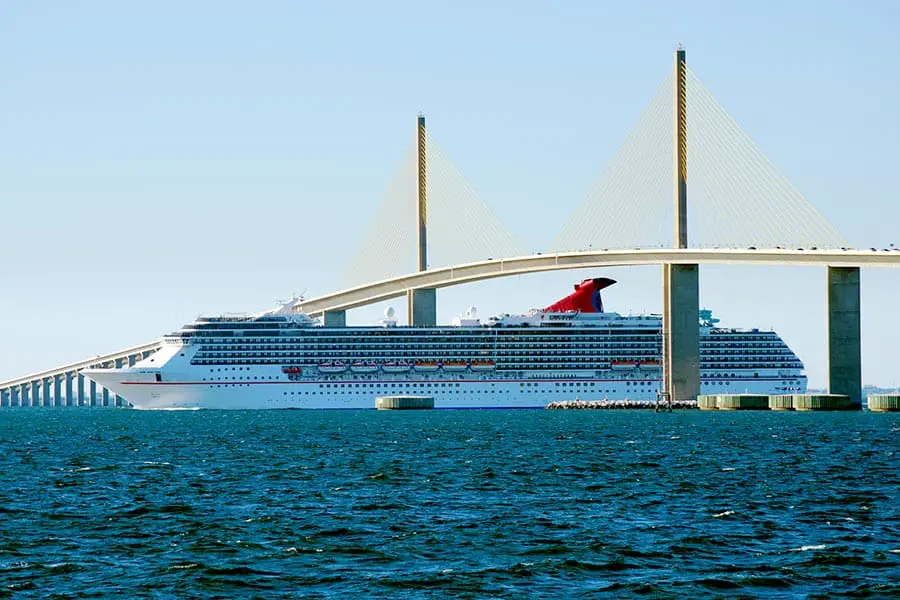
The Sunshine Skyway Bridge that spans Tampa Bay is actually the third iteration of the Sunshine Skyway. Plans for the original Skyway were announced on July 4, 1950, as America built up her infrastructure in the wake of World War II.
To name the bridge, officials held a contest where citizens could write in and suggest names; the famous Sunshine Skyway name was suggested by a resident of Indian Rocks, Florida named Virginia Seymore.
The bridge was constructed over the course of several years and opened to traffic on September 6, 1954. The original bridge rose 150 feet above the surface of the bay at a 5% grade. The bridge contributed massively to the growth and development of St. Petersburg and Pinellas County, as people from mainland Florida could easily get to the Pinellas Peninsula using the bridge.
In 1969, the bridge was expanded with a second span parallel to the first. The second span added traffic capacity to the bridge and brought it up to modern highway standards. Unfortunately, due to some minor structural problems, the opening of the second span of the Skyway Bridge was delayed until 1971.
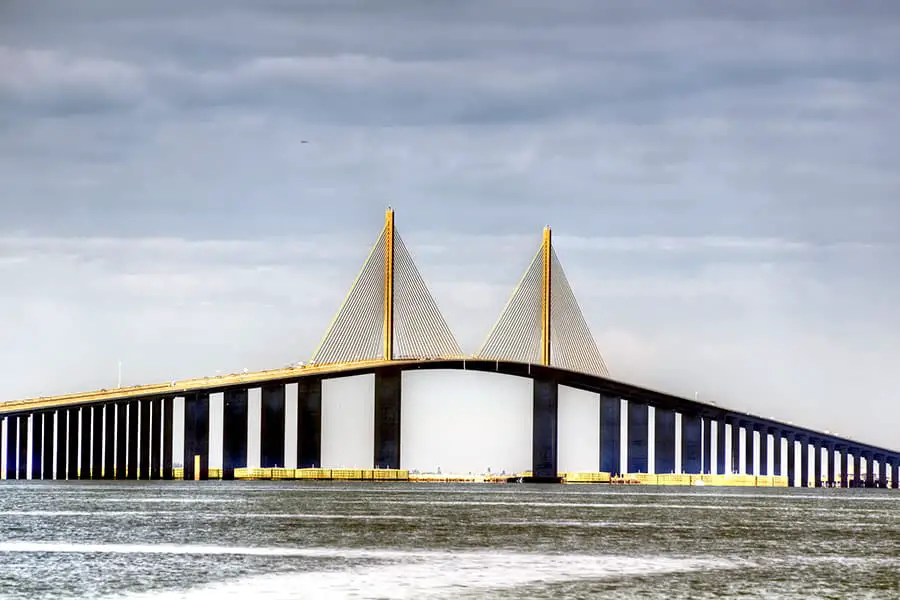
On January 28, 1980, the Sunshine Skyway experienced its first significant tragedy when the U.S. Coast Guard cutter Blackthorn collided with the tanker ship Capricorn while navigating through the channel beneath the Skyway. The accident resulted in the sinking of the Blackthorn after the Capricorn’s anchor dropped and tore open the hull of the cutter. Twenty-three crew members aboard the Blackthorn were killed in the collision.
Later in 1980, the bridge experienced another catastrophe when the freighter ship MV Summit Venture sailed into a pier during a sudden rain squall. The collision caused 1,200 feet of the bridge to subsequently collapse into Tampa Bay, sending six cars, a truck, and a bus into the water and leading to the death of 35 people.
A later investigation cleared the harbor pilot who was steering the vessel of wrongdoing. The ship had been struck by a microburst that effectively shoved it into the bridge, and the captain’s actions were deemed appropriate by the U.S. Coast Guard.
After this disaster, the current version of the Sunshine Skyway Bridge was designed and built. The existing bridge is 50% wider and 40 feet higher than the old bridge and runs 4.14 miles from end to end. Like the original, the new Skyway Bridge connects St. Petersburg to Terra Ceia and is part of Highway 275 and U.S. 19.
Several new safety features were included in the bridge, including concrete “dolphins” that sit about ¼ mile out from the bridge pylons and serve to protect the bridge’s structure from collisions with vessels. The old bridge was demolished, but a portion of it was preserved and now functions as the Skyway Fishing Pier State Park.
Phenomenal Florida Fun Fact: In 2018, the Armed Forces Families Foundation held a race called the Skyway 10K, which has become an annual event. The bridge is closed to traffic, and runners compete in running across the bridge in honor of those who served in the armed forces and their families.
The Sunshine Skyway Bridge cost about $244 million to build in 1987 dollars, which is the equivalent of about $558 million in 2019 dollars.
The bridge requires maintenance and upkeep, so to help keep it safe and sturdy, motorists who cross the bridge are charged a $1.50 toll, payable in cash or through Florida’s electronic tolling system, the Sunpass.
While the view from the top of the bridge is fantastic, do not stop on the Skyway: non-emergency stopping on the bridge will result in a ticket, and the Florida Highway Patrol does regularly patrol the Skyway.
Other Posts of Interest
- Are There Sharks In Tampa Bay?
- Which Florida Coast Is Better for Fishing?
- Can You Boat Across Florida?
- Why Does Florida Have So Many Canals?
What Type of Bridge is the Sunshine Skyway Bridge?
The Sunshine Skyway Bridge is a kind of bridge known as a cable-stayed bridge. Cable-stayed bridges are defined by the presence of towers or pylons, from which cables connect to the bridge’s surface and hold up the deck. Each supporting cable for the bridge connects directly to a pylon. This design creates long, parallel lines between the cables and gives these bridges a distinctive appearance.
Isn’t that just like a suspension bridge? Almost, but not quite. Suspension bridges also have pylons, but the cables that support the load of the bridge don’t connect directly to the pylons. Instead, the pylons support long suspension cables, from which vertical suspenders connect to the bridge deck. This is a subtle difference, but it affects the loading of the bridge in ways that are very important to bridge designers.
How Steep is the Sunshine Skyway Bridge?
The Sunshine Skyway Bridge is notoriously steep. The bridge is built at a 4% grade, meaning that for every 100 feet forward, the bridge rises about 4 feet. The bridge arcs up to its maximum height of 430 feet over the course of several miles. The bridge spans about 4.14 miles from end to end. Between the length and the height of this bridge, driving over the Sunshine Skyway is truly a wild experience!
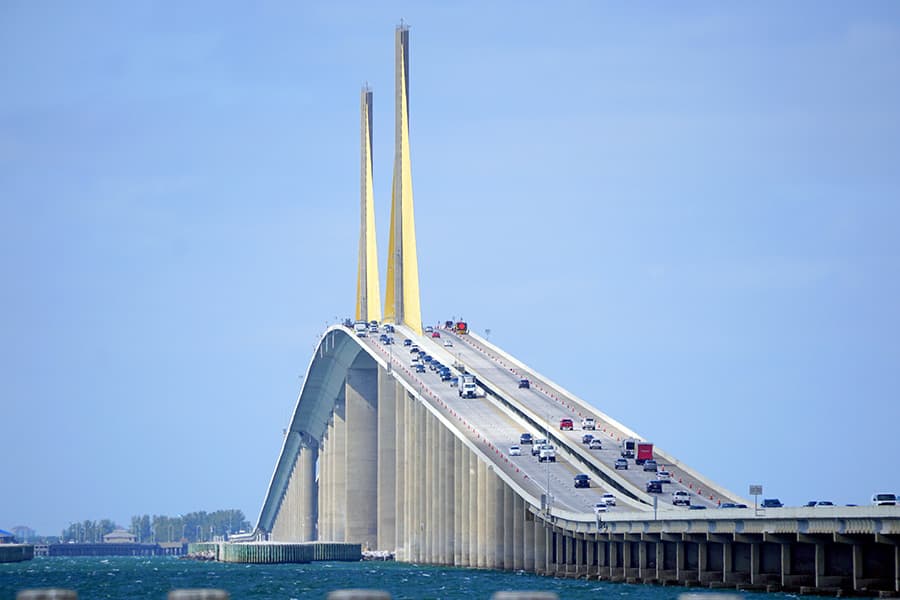
Does the Sunshine Skyway Bridge Light up at Night?
The Sunshine Skyway Bridge is a beautiful piece of architecture made even more beautiful by the installation of more than 1,800 LED lights. These lights can be set to change colors. The authorities who run the bridge often change the color pattern to reflect special events: they’ve done red, white, and blue colors to honor local first responders and military veterans, and other special events.
Installing the lighting system on the Skyway cost the Florida Department of Transportation about 15 million dollars. This amount might sound like an astronomical amount of money, but installing lights on a house or Christmas tree is far easier than installing lights on a massive bridge.
In addition to the color-changing LED displays, the Skyway Bridge also has several static light fixtures that illuminate the road surface at night or during inclement weather.
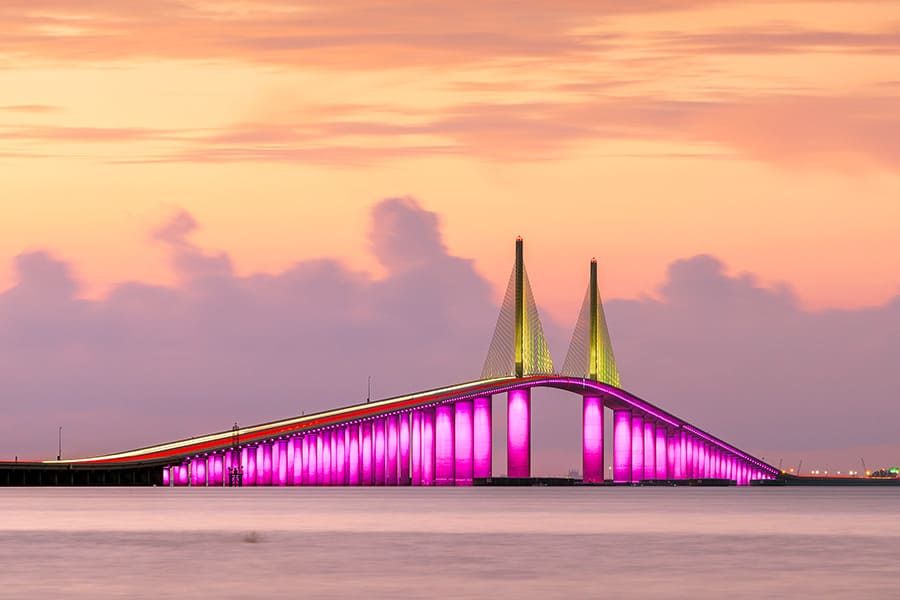
Can You Walk Across the Sunshine Skyway Bridge?
The Sunshine Skyway Bridge offers some beautiful views, but you’ll have to be in your car to see them. Pedestrians and bicyclists are not allowed on the main span of the Sunshine Skyway. However, there are several parks near the bridge that offer great views and fun activities. Maximo Park in St. Petersburg has a splendid view of the bridge, plus boat ramps, picnic areas, playgrounds, and other amenities.
Another popular way to experience the Skyway without driving over it is to head to the Skyway Fishing Pier State Park. Admission to the park is $4 per vehicle and $4 per adult. The pier is a popular and convenient spot for anglers to drop their lines into the water. It’s also very popular for night fishing! Common catches include tarpon, grouper, snook, sea bass, cobia, red snappers, and more.
How Deep is the Water Under Sunshine Skyway Bridge?
Tampa Bay is not a tremendously deep body of water. The maximum depth of the bay is about 82 feet. However, most of the bay is between 10 and 20 feet deep; the average depth is 11 feet. Several shipping channels have been dredged to allow the passage of large vessels like cruise ships and container ships, but the bay is generally pretty shallow.
The water level under the Sunshine Skyway Bridge varies depending on how far from shore you are. According to NOAA navigation charts, the water close to shore is between 1 foot and 10 feet deep, and the water under the middle of the bridge is between 20-25 feet. The deepest water under the bridge is the Mullet Key Channel, which is about 35 feet deep.
Over The Bridge
While the Skyway is a huge bridge, modern shipping vessels have evolved since the 1980s. Despite sitting almost 200 feet above the water, the Skyway’s deck is too short for some modern ships to pass under. There are whispers that a newer, even taller bridge may eventually replace the Sunshine Skyway! But until that time comes, the Sunshine Skyway remains a marvel of modern engineering.
Not only is it a marvel, but it is also a beauty. The cable-stayed design makes the bridge instantly recognizable. In addition, it is a heavily traveled and prevalent route, allowing commuters and tourists alike to easily travel to and from the southern tip of the Pinellas Peninsula. Driving over the bridge, with its high deck, steep grade, and lofty views of the city and the bay is a highlight of any traveler’s visit to the Tampa Bay Area.
